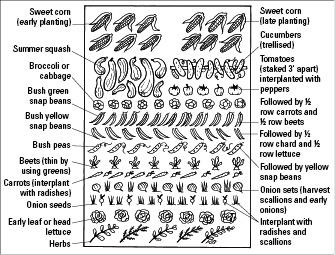Vegetable Gardening (116 page)

 White clover
White clover
may repel cabbage root flies.
 Wormwood
Wormwood
may repel flea beetles.
Many herbs, such as rosemary, oregano, and coriander, also are said to repel pests. Smaller companion plants, such as marigolds, can be interplanted with vegetables. Taller or more vigorous plants, such as ryegrass or wormwood, should be planted nearby — but not among — vegetables. You don't want them to overwhelm your veggie plants.
The research on companion planting may be thin, but hey, give it a try to see if it works!
Making Your Garden Work Double Time with Intercropping
Intercropping
is a space-saving technique in which you grow fast-maturing, smaller crops among slower-growing, larger vegetables. By the time the bigger plants start to take over, you have already harvested the crops in between. Intercropping makes one bed as productive as two.
 The best crops for intercropping include beets, carrots, lettuce, onions, radishes, spinach, and turnips. Use these examples to help you decide how to do it:
The best crops for intercropping include beets, carrots, lettuce, onions, radishes, spinach, and turnips. Use these examples to help you decide how to do it:
 Plant lettuce, carrots, or radishes among young tomatoes and broccoli. For that matter, plant carrots and radishes wherever you have open space.
Plant lettuce, carrots, or radishes among young tomatoes and broccoli. For that matter, plant carrots and radishes wherever you have open space.
 Plant turnips and other root crops among your cabbage.
Plant turnips and other root crops among your cabbage.
 Plant spinach or lettuce under your bean trellis. As the weather warms, the beans will shade the spinach and keep it cool.
Plant spinach or lettuce under your bean trellis. As the weather warms, the beans will shade the spinach and keep it cool.
 Plant green onions between rows of corn.
Plant green onions between rows of corn.
Succession Planting for an Extended Harvest
Succession planting
is a method of extending the harvest of vegetables, such as radishes and corn, that ripen all at once and lose quality if left in the garden instead of being harvested. Farmers use the technique to ensure a constant supply of vegetables to take to market; you can use it to produce a consistent supply of vegetables to take to your table. To succession plant, you simply make smaller plantings separated by 2 to 3 weeks instead of planting everything at once. Some great crops to succession plant are lettuce and greens, bush beans, beets, carrots, onions, radish, spinach, and sweet corn.
 If you want to experiment with succession planting, use these steps:
If you want to experiment with succession planting, use these steps:
1. Figure out how much of a certain vegetable your family needs for a 2- to 3-week period and how much room it will take to grow it.
Figure 16-1 shows a sample garden plan for succession planting. Check out Chapter 3 for additional information on how to plan your garden.
2. Break your planting beds into three or four appropriate-sized sections to grow your 2- to 3-week supply of the vegetable.
3. At the start of the planting season, plant the first bed; wait about 2 weeks and plant the second bed, and then plant the third bed about 2 weeks later.
Just about the time you finish harvesting the first bed, the second bed will be ready to harvest.
Figure 16-1:
A sample plan of succession plantings.
The length of your planting season will determine how many successive plantings you can make and how successful the later plantings are. Depending on the weather, some of your later plantings may not yield well, but that's another reason to plant a number of plantings through the season: you're sure to get some of every type of veggie.
Another way to use succession planting is to replace a crop that's finished producing with a new one in the same place. With this method, you can grow more and a wider variety of vegetables in a small space. Just make sure you're planting a cool-season veggie for spring or fall and a warm-season veggie for summer. Table 16-1 lists some good succession planting combinations to try. (Chapter 3 has more information on cool-season and warm-season veggies.) You can choose one veggie from each column to plant in succession.

Yet another way to ensure a constant harvest of vegetables is to plant using the
square foot method.
This method is for the mathematically inclined (even though you don't need an A in calculus to use it). You select a 4-foot-by-4-foot section of your garden and divide it into 16 squares (each section is 1 square foot). Each square will have a different number of plants, depending on what you're growing:

